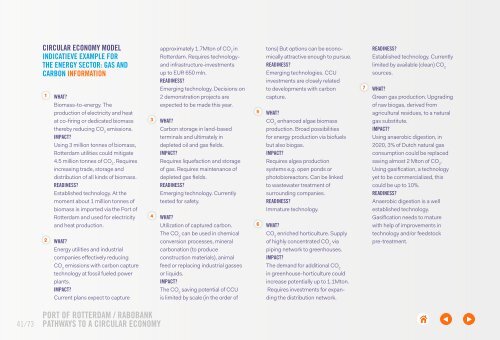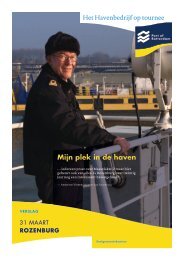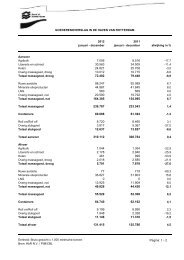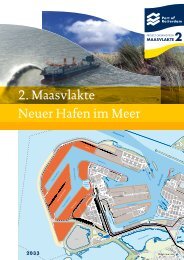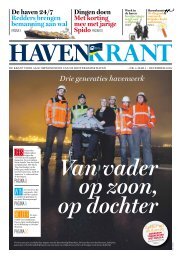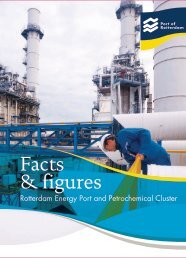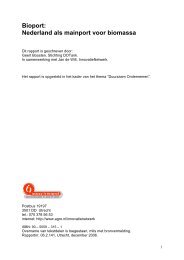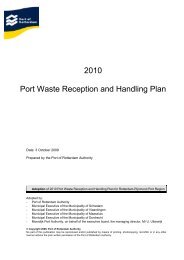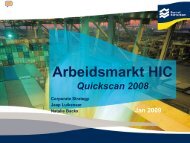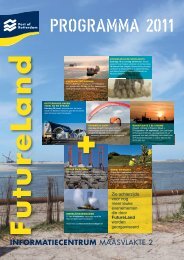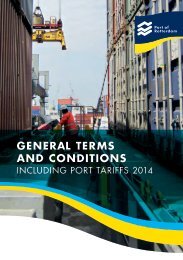PATHWAYS TO A CIRCULAR ECONOMY - Port of Rotterdam
PATHWAYS TO A CIRCULAR ECONOMY - Port of Rotterdam
PATHWAYS TO A CIRCULAR ECONOMY - Port of Rotterdam
Create successful ePaper yourself
Turn your PDF publications into a flip-book with our unique Google optimized e-Paper software.
Circular economy modelIndicatieve example forthe Energy sector: Gas andcarbon InformationWhat?Biomass-to-energy. Theproduction <strong>of</strong> electricity and heatat co-firing or dedicated biomassthereby reducing CO 2emissions.Impact?Using 3 million tonnes <strong>of</strong> biomass,<strong>Rotterdam</strong> utilities could mitigate4.5 million tonnes <strong>of</strong> CO 2. Requiresincreasing trade, storage anddistribution <strong>of</strong> all kinds <strong>of</strong> biomass.Readiness?Established technology. At themoment about 1 million tonnes <strong>of</strong>biomass is imported via the <strong>Port</strong> <strong>of</strong><strong>Rotterdam</strong> and used for electricityand heat production.What?Energy utilities and industrialcompanies effectively reducingCO 2emissions with carbon capturetechnology at fossil fueled powerplants.Impact?Current plans expect to captureapproximately 1.7Mton <strong>of</strong> CO 2in<strong>Rotterdam</strong>. Requires technologyandinfrastructure-investmentsup to EUR 650 mln.Readiness?Emerging technology. Decisions on2 demonstration projects areexpected to be made this year.What?Carbon storage in land-basedterminals and ultimately indepleted oil and gas fields.Impact?Requires liquefaction and storage<strong>of</strong> gas. Requires maintenance <strong>of</strong>depleted gas fields.Readiness?Emerging technology. Currentlytested for safety.What?Utilization <strong>of</strong> captured carbon.The CO 2can be used in chemicalconversion processes, mineralcarbonation (to produceconstruction materials), animalfeed or replacing industrial gassesor liquids.Impact?The CO 2saving potential <strong>of</strong> CCUis limited by scale (in the order <strong>of</strong>tons) But options can be economicallyattractive enough to pursue.Readiness?Emerging technologies. CCUinvestments are closely relatedto developments with carboncapture.What?CO 2enhanced algae biomassproduction. Broad possibilitiesfor energy production via bi<strong>of</strong>uelsbut also biogas.Impact?Requires algea productionsystems e.g. open ponds orphotobioreactors. Can be linkedto wastewater treatment <strong>of</strong>surrounding companies.Readiness?Immature technology.What?CO 2enriched horticulture. Supply<strong>of</strong> highly concentrated CO 2viapiping network to greenhouses.Impact?The demand for additional CO 2in greenhouse-horticulture couldincrease potentially up to 1.1Mton.Requires investments for expandingthe distribution network.Readiness?Established technology. Currentlylimited by available (clean) CO 2sources.What?Green gas production. Upgrading<strong>of</strong> raw biogas, derived fromagricultural residues, to a naturalgas substitute.Impact?Using anaerobic digestion, in2020, 3% <strong>of</strong> Dutch natural gasconsumption could be replacedsaving almost 2 Mton <strong>of</strong> CO 2.Using gasification, a technologyyet to be commercialized, thiscould be up to 10%.Readiness?Anaerobic digestion is a wellestablished technology.Gasification needs to maturewith help <strong>of</strong> improvements intechnology and/or feedstockpre-treatment.41/73PORT OF ROTTERDAM / RABOBANK<strong>PATHWAYS</strong> <strong>TO</strong> A <strong>CIRCULAR</strong> <strong>ECONOMY</strong>


